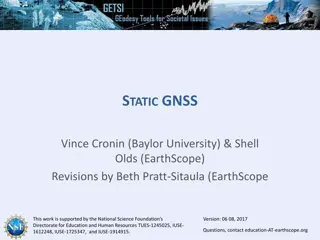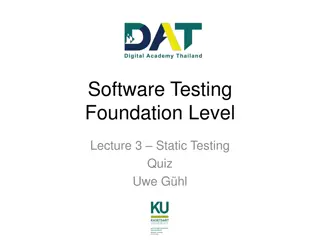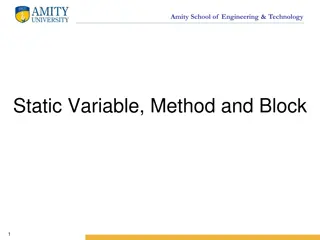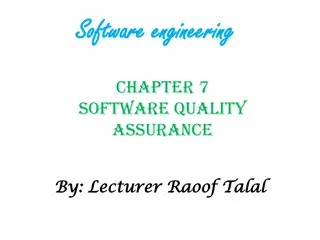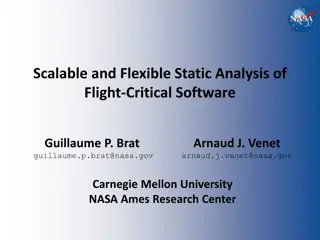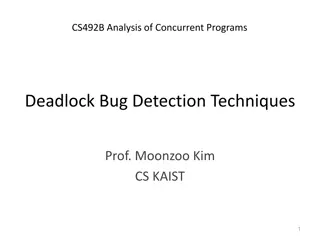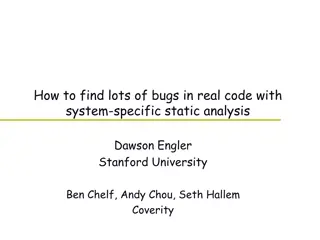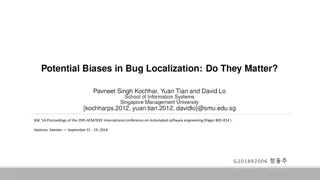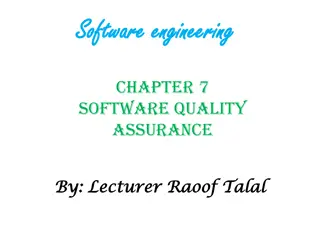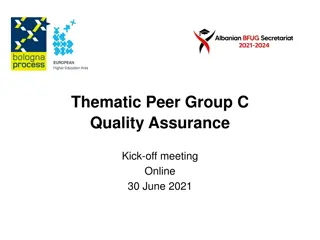Overview of Static Bug Detection in Software Quality Assurance
Static bug detection is a less popular but effective approach for software quality assurance compared to traditional testing methods. It involves tools like Findbugs that help identify potential issues in code before deployment, such as bad coding styles, null pointer dereferences, and malicious code vulnerabilities. By utilizing defined oracles and state-of-the-art practices, developers can improve the overall quality and reliability of their software.
Download Presentation

Please find below an Image/Link to download the presentation.
The content on the website is provided AS IS for your information and personal use only. It may not be sold, licensed, or shared on other websites without obtaining consent from the author.If you encounter any issues during the download, it is possible that the publisher has removed the file from their server.
You are allowed to download the files provided on this website for personal or commercial use, subject to the condition that they are used lawfully. All files are the property of their respective owners.
The content on the website is provided AS IS for your information and personal use only. It may not be sold, licensed, or shared on other websites without obtaining consent from the author.
E N D
Presentation Transcript
Static analysis Hao Zhong Shanghai Jiao Tong University
Last class Quality engineer Faults and their detection approaches Test Unit test Integration test System test Test coverage
Testing bugs code executable file compile test case
Static bug detection AST bugs code graph check parse model oracle
Static bug detection Static bug detection is a less popular approach for software quality assurance, compared with testing Research opportunity Compared to testing Work for specific kinds of bugs Sometimes not scalable Generate false positives Easy to start ( no setup, no install ) Sometimes can guarantee the software to be free of certain kinds of bugs No need for debugging
State-of-practice: static bug detection Findbugs A tool developed by researchers from UMD Widely used in industry for code checking before commit The idea actually comes from Lint Lint A code style enforcing tool for C language Find bad coding styles and raise warnings Bad naming Hard coded strings
Defined oracles in Findbugs Bad practice DMI: Don't use removeAll to clear a collection If you want to remove all elements from a collection c, use c.clear, not c.removeAll(c). Calling c.removeAll(c) to clear a collection is less clear, susceptible to errors from typos, less efficient and for some collections, might throw a ConcurrentModificationException. Correctness NP: Null pointer dereference A null pointer is dereferenced here. This will lead to a NullPointerException when the code is executed. Malicious code vulnerability MS: Field isn't final and can't be protected from malicious code A mutable static field could be changed by malicious code or by accident from another package.
Defined oracles in Findbugs Performance Dm: Method invokes inefficient Boolean constructor Creating new instances of java.lang.Boolean wastes memory, since Boolean objects are immutable and there are only two useful values of this type. Use the Boolean.valueOf() method (or Java 1.5 autoboxing) to create Boolean objects instead. Multithreaded correctness SWL: Method calls Thread.sleep() with a lock held This method calls Thread.sleep() with a lock held. This may result in very poor performance and scalability, or a deadlock, since other threads may be waiting to acquire the lock. It is a much better idea to call wait() on the lock, which releases the lock and allows other threads to run.
Defined oracles in Findbugs Security Dm: Hardcoded constant database password This code creates a database connect using a hardcoded, constant password. Anyone with access to either the source code or the compiled code can easily learn the password.
Characters of Findbugs More than 400 rules Bug patterns include both specifications and bug signatures Most are bug signatures Why? Check code patterns locally: only do inner-procedure analysis What are the advantages and disadvantages of doing so? Perform bug ranking according to the probability and potential severity of bugs Probability: the bug is likely to be true Severity: the bug may cause severe consequence if not fixed
Application of Findbugs-like tools Findbugs is adopted by a number of large companies such as Google Usually only the issues with highest confidence/severity are reported as issues A statistics in Google 2009: More than 4000 issues are identified, in which 1700 bugs are confirmed, and 1100 are fixed. The software department of USAA is using PMD, an alternative of Findbugs
Problems of Fingbugs Lack of oracles Very rare project-specific formal specification Solutions: General specifications (for typical bugs) Mining specifications (for API-specific, project-specific specifications) Mining bug signatures False Positives vs. Efficiency More sensitivities higher cost Path sensitivity is rarely achieved Combination of all sensitivities Incomputable problems
Oracle Tools such as Findbugs already defined hundreds of rules. Why insufficient? API library J2SE alone defines thousands of classes Static tools handle APIs as black boxes Project-specific rules Outsiders rarely know Static tools do not define project-specific rules It is challenging to define such rules manually Even if we fully understand a type of bugs (NPE), it is infeasible to identify them, since we have insufficient rules.
Oracle Specification A description of the correct behaviors of software Bug signature A description of the incorrect behaviors of software We must have formal specifications/bug signatures Value Temporal Data Flow Why does it matter in static analysis? Testing?
General oracles Divide by 0 a/b b!=0 Null Pointer Reference a.field a!=null Buffer Overflow a[x] x<a.length() p.malloc() p.free() Memory Leak deadlock Infinite Loop lock(s) unlock(s) while(Condition) F(!Condition)
Value oracle The value (s) of one or several variable (s) must satisfy a certain constraint Final Exam Score <= 100 sortedlist(0) >= sortedlist(1) http_url.startsWith( http ) Techniques Inference Mining (Daikon)
Inference Static symbolic execution y = read(); y = 2 * y; if (y <= 12) y = 3; else y = y + 1; print ("OK"); T (y=s), s is a symbolic variable for input T (y=2*s) T2*s<=12 (y = 3) T!(2*s<=12) (y= 2*s + 1) T 2*s<=12 (y= 3 ) | T!(2*s<=12) (y=2*s + 1) y=3|2*s>12 s>6 y=2*s+1 y>13 API?
Mining Original program Instrumented program Data trace database Invariants Detect invariants Instrument Run Test suite Dynamically discovering likely program invariants to support program evolution by Michael D. Ernst, Jake Cockrell, William G. Griswold, and David Notkin. IEEE Transactions on Software Engineering, vol. 27, no. 2, Feb. 2001, pp. 99-123. Accuracy?
Temporal oracle Two events (or a series of events) must (not) happen in a certain order Specification lock() unlock() file.open() file.close() and file.open() file.read() Bug signature file.close() file.read() They are different, right? Temporal Logic lock()F(unlock()) (spec) close()F(read()) (bug signature)
Temporal logic U: until pUq means that p has to be true until q is true !read(f)Uopen(f) !close(f)Uopen(f) F: future Fp means that p will be true some time in future open(f)Fclose(f) close(f)!Fread(f)
Mining specifications Robillard, Martin P., Eric Bodden, David Kawrykow, Mira Mezini, and Tristan Ratchford. "Automated API property inference techniques." IEEE Transactions on Software Engineering 39, no. 5 (2013): 613-637. Learning from correct usages Inputs Client code Traces Techniques: Frequent sequential mining Frequent subgraph mining Grammar inference Output Automata Frequent call sequences Graphs Prof. Tao Xie Prof. Andreas Zeller
Mining specifications Learning from documents Inputs API doc Techniques: NLP Outputs:
Mining bug signature Learning from bugs Inputs Buggy code Buggy traces Techniques Frequency-based mining Mining subgraph Discriminative graph mining Outputs:
Data flow specification Data from a certain source must / must not flow to a certain sink Android applications ! Contact Info Internet Password encryption Internet Data Flow Specification are mainly for security usage
Code style Method names H st, Einar W., and Bjarte M. stvold. "Debugging method names." InEuropean Conference on Object-Oriented Programming, pp. 294-317. Springer, Berlin, Heidelberg, 2009. Parameter and argument names Hui Liu, Qiurong Liu, Cristian-Alexandru Staicu, Michael Pradel, Yue Luo. Nomen est Omen: Exploring and Exploiting Similarities between Argument and Parameter Names. The 38th International Conference on Software Engineering (ICSE 2016), 1063-1073
More oracles: documentation Zhong, Hao. and Su, Zhendong., 2013, Detecting API documentation errors. In Proc. OOPSLA, pp. 803-816). Natural language sentence with code names Out-of-date code reference Natural language sentence Code example
More oracles: differential testing An application has multiple implementations JVM: Sun J2SE, Open JDK, IBM J9, Compiler: gcc, llvm, SSH servers: Apache MINA SSHD, Dropbear, Linux: Ubuntu, Redhat, Refactoring One software has different implementations Same inputs Same outputs Prof. Zhendong Su Compiler Validation via Equivalence Modulo Inputs. Vu Le, Mehrdad Afshari, and Zhendong Su. In Proceedings of PLDI'14, Edinburgh, UK, June 9-11, 2014. SIGPLAN Distinguished Paper Award
What after you have oracles? It is still nontrivial to check whether a program follow or violate oracle. It is often more difficult to determine violations. It is often infeasible to obtain full information of a program, due to various limitations. We have to live with imprecise results (false alarms).
Static bug detection AST bugs code graph check parse model oracle
Graph-based analysis Transform the program to graphs WALA, SOOT Detecting violations of specifications traversing graphs Detecting instances of bug signatures identifying subgraphs
An example f is not closed Start Checking whether a file is closed in all cases boolean load(){ f.open(); line = f.read(); while(line!=null){ if(line.contains('key')){ f.close() return true; }else if(line.contains('value')){ f.close() } line = f.read(); } return false; } opened new line read !=null key value closed none ==null closed ret
The challenges of bug analysis Johnson, Brittany, Yoonki Song, Emerson Murphy-Hill, and Robert Bowdidge. "Why don't software developers use static analysis tools to find bugs?." In Proc. ICSE, pp. 672-681. 2013. Some programmers hate false alarms Legunsen O, Hassan Wu, Xu X, Ro u G, Marinov D. How good are the specs? A study of the bug-finding effectiveness of existing Java API specifications. In Proc. ASE 2016 (pp. 602-613). 182 manually written specs and 17 automatically mined specs 200 open source projects JavaMOP (dynamic) We reported 95 bugs, out of which developers already fixed 74. Most violations, 82.81% of 652 and 97.89% of 200, were false alarms
Ranking detected bugs Sunghun Kim and Michael D Ernst. 2007. Which warnings should I fix first?. In Proc. ESEC/FSE. 45 54. In this paper, we propose a history-based warning prioritization algorithm by mining warning fix experience that is recorded in the software change history. The underlying intuition is that if warnings from a category are eliminated by fix- changes, the warnings are important. Our prioritization algorithm improves warning precision to 17%, 25%, and 67% respectively.
This class Static bug detection Oracle Value Temporal Data flow Detection techniques Symbolic execution Graph-based approaches Oracle inference Mining oracles Existing client code Existing buggy code Documents Code styles Declaration before usage
Next class Debugging




